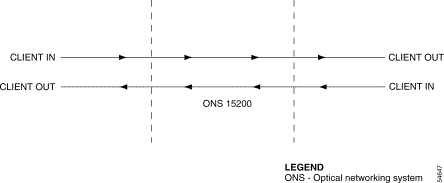|
|

This chapter presents the general system technology and the available protection architectures for Cisco's dense wavelength division multiplexing (DWDM) metro system, the Cisco ONS 15200.
The ONS 15200 DWDM metro system transports data over wavelengths using fiber-optic cables. The ONS 15200 operates in the 1550-nm transmission window. Over a single optical fiber pair, the ONS 15200 can carry up to 32 channels of data in the following bit rates and formats:
Protected or unprotected data can transmit over the ONS 15200.
The optical layer is independent of the electronic protocol that is external to the ONS 15200 system. You can use any higher-level protocol, including proprietary products, within the ONS 15200 system. Any protocol used must fulfill the requirements listed in this book, including the bit rates listed in this section.
In the ONS 15200 system, optical channels transport information between two client-layer interface ports. All optical channels in the ONS 15200 system are duplex channels, which means that traffic flows in both directions. The optical channels can be unprotected, as described in the "Unprotected Channels" section, or protected, as described in the "Protected Channels" section.
In an unprotected channel, protection fiber is not available. Only one fiber sends traffic to the client layer of the receiving node. You can use unprotected channels where protection is not needed or if the client layer provides protection. Cisco recommends that you only use protection in one layer and avoid potentially conflicting protection schemes. You can add protection in the client layer described in the "Physical Layout" section. Figure 1-1 displays an example of ONS 15200 unprotected channels.

In optically protected channels, data traffic flows in two physically separated streams to the receiving node. The configuration of the receiving node determines which traffic flow is transferred to the client layer of the receiving node. Figure 1-2 displays an example of optical fiber-protected channels in an ONS 15200 system. This form of optical channel protection is rapid and provides continued system coverage in case of fiber breaks between nodes.

Client-layer protection schemes for the ONS 15200 are:
In Release 1.1 and later, the 2R/3R (unclocked/clocked) Client Layer Interface Port (CLIP) module is user configurable for unprotected or fiber protected operation. (See Cisco ONS 15200 Command Line Interface Manual, R1.1).
 |
Note The 2R function retransmits the optical signal with electrical reamplification and reshaping but without retiming. The 3R function reamplifies, reshapes, and retimes the optical signal. |
![]()
![]()
![]()
![]()
![]()
![]()
![]()
![]()
Posted: Mon Sep 30 23:08:43 PDT 2002
All contents are Copyright © 1992--2002 Cisco Systems, Inc. All rights reserved.
Important Notices and Privacy Statement.